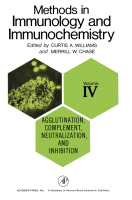Browse content
Table of contents
Actions for selected chapters
- Full text access
- Book chapterAbstract only
CHAPTER 16 - Agglutination and Flocculation
Pages 1-125 - Book chapterAbstract only
CHAPTER 17 - Complement
Pages 127-274 - Book chapterAbstract only
CHAPTER 18 - Neutralization Reactions
Pages 275-398 - Book chapterNo access
APPENDIX I - World Health Organization Report on Nomenclature of Complement
Pages 399-405 - Book chapterNo access
APPENDIX II - The International System of Units: SI Nomenclature
Pages 407-410 - Book chapterNo access
Author Index
Pages 411-427 - Book chapterNo access
Subject Index
Pages 428-468
About the book
Description
Methods in Immunology and Immunochemistry, Volume IV: Agglutination, Complement, Neutralization, and Inhibition provides information pertinent to direct and indirect agglutination reactions. This book covers a variety of topics, including complement-fixation procedures, isolation of complement components, hemolytic intermediates, complement-related proteins, and neutralization reactions. Organized into three chapters, this volume begins with an overview of test-tube agglutinations that are preferred for blood grouping with saline agglutinins that require more than a few minutes for agglutination. This text then describes blood group antibodies that agglutinate red blood cells suspended in saline. Other chapters consider the classical pathway of complement utilization. This book discusses as well the complexity of events leading to hemolysis of erythrocytes by complement. The final chapter deals with the ability of antitoxin to neutralize diphtheria toxin and explains the quantitative relationships between antigen and antibody. This book is a valuable resource for immunologists, scientists, and research workers.
Methods in Immunology and Immunochemistry, Volume IV: Agglutination, Complement, Neutralization, and Inhibition provides information pertinent to direct and indirect agglutination reactions. This book covers a variety of topics, including complement-fixation procedures, isolation of complement components, hemolytic intermediates, complement-related proteins, and neutralization reactions. Organized into three chapters, this volume begins with an overview of test-tube agglutinations that are preferred for blood grouping with saline agglutinins that require more than a few minutes for agglutination. This text then describes blood group antibodies that agglutinate red blood cells suspended in saline. Other chapters consider the classical pathway of complement utilization. This book discusses as well the complexity of events leading to hemolysis of erythrocytes by complement. The final chapter deals with the ability of antitoxin to neutralize diphtheria toxin and explains the quantitative relationships between antigen and antibody. This book is a valuable resource for immunologists, scientists, and research workers.
Details
ISBN
978-0-12-754404-5
Language
English
Published
1977
Copyright
Copyright © 1977 Elsevier Inc. All rights reserved.
Imprint
Academic Press
